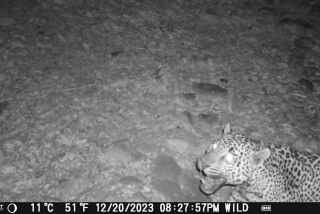Colorado’s barroom birders spy an odd duck : A rare Baikal teal blew in from Siberia. So now the binocular set is flocking in to quaff and survey.
- Share via
KITTREDGE, Colo. — Hard-core bird-watchers have no trouble slogging through swamps, frozen wastelands and sizzling deserts to catch a glimpse of a rare bird.
But the Baikal teal that blew in to this Rocky Mountain village last month has made that kind of exertion unnecessary. It hunkered down with a flock of mallards outside the picture window of the Bear Creek Tavern, giving birders a vantage point that is almost embarrassingly comfortable.
Bill Brockner, Colorado’s preeminent bird-watcher, theorizes that the female Baikal teal was blown thousands of miles off course by a storm during its winter migration from eastern Siberia to the northern islands of Japan.
Now, binocular-toting birders from the West Indies, Britain and across the nation are traveling nearly as far to belly up to the bar and ogle the duck that has been lounging a few yards behind the tavern in Bear Creek.
“When I first heard it had been spotted here I nearly had a heart attack,” said Brockner, 77, who was the first to positively identify the duck. “This bird has only been seen seven times in the continental United States.”
This time, he added, “the best place to watch her is right out the window of the bar.”
Bartender Steve Dalton is bemused by all the commotion over a small, plain-looking, brownish duck.
“Interesting little bugger. She sure can draw a crowd,” Dalton said the other day as he was mixing Bloody Marys for a new breed of clientele training spotting scopes over his pine and cedar bar top. “Around here, the best view folks normally get of a duck is through a gun sight.”
Hunters may be the least of this Baikal teal’s worries. One recent day, a goshawk wheeling over Bear Creek suddenly swooped down toward the flock of mallards, prompting Brockner to yell: “Don’t touch our bird!”
Unruffled by the attack, the teal sat quietly on a snowbank, basking in the dappled sunlight.
“The goshawk was searching for a weak mallard it could knock off easily,” Brockner said. “The teal stays with the flock because it wants to be near kissing cousins and follow them around for protection and food.”
The bird has a white spot at the base of its bill, and gray, brown and white feathers.
Among a cluster of birders here one recent Sunday was diagnostic radiologist David Cheffin of Cleveland, Tenn. Cheffin had hopped on a jet after learning about the teal on the Audubon Society’s rare bird alert hot line, a tape-recorded message of noteworthy birds seen throughout the nation.
“I couldn’t pass this up. It’s one of those occurrences that may never happen again in my lifetime,” Cheffin said. “You get a good feel for God’s nature when you know one of his creations can be blown out of its habitat, withstand that kind of treatment and then come to a place like this.”
Still, Brockner, who has spotted 736 of the 850 birds that can possibly be seen in North America, figures the teal’s future is uncertain.
“Periodically we have invasions of snowy owls from Alaska, and studies show that many of them never get back to the Arctic because they die along the way,” Brockner said. “I hope she makes it back, but chances are slim that she will.”
Even if she beats the odds, Brockner pointed out that Baikal teal populations in eastern Siberia are shrinking dramatically and that scientists are at a loss to explain why.
“Historically, you could see flocks of 100,000 Baikal teals in Siberia,” Brockner said. “Current estimates are of as few as 40,000, and we don’t know why.”
Bear Creek Tavern owner Chuck Koch, who has been feeding the mallards behind his establishment 300 pounds of cracked corn a week for 12 years, would prefer that the town’s newest celebrity stays put.
“She’s the most exciting thing to happen here in 18 years,” Koch said. “It’s been a lot of fun meeting people from all over the world.”
More to Read
Sign up for Essential California
The most important California stories and recommendations in your inbox every morning.
You may occasionally receive promotional content from the Los Angeles Times.














